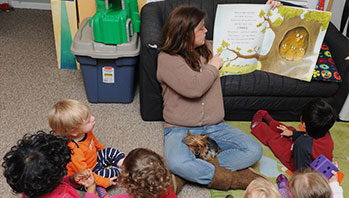-
any plants children have been growing
- aboveground
- leaves
- plant
- roots
- underground
MA Standards:
English Language Arts/Literature/RL.PK.MA.1: With prompting and support, ask and answer questions about a story or a poem read aloud.
English Language Arts/Literature/RL.PK.MA.4: With prompting and support, ask and answer questions about unfamiliar words in a story or poem read aloud.
English Language Arts/Literature/RL.PK.MA.9: With prompting and support, make connections between a story or poem and one’s own experiences.
Head Start Outcomes:
Literacy Knowledge/Book Appreciation and Knowledge: Asks and answers questions and makes comments about print materials.
PreK Learning Guidelines:
English Language Arts/Reading and Literature 6: Listen to a wide variety of age appropriate literature read aloud.
English Language Arts/Reading and Literature 10: Engage actively in read-aloud activities by asking questions, offering ideas, predicting or retelling important parts of a story or informational book.
Read Together: Vegetable Garden #2

© Commonwealth of Massachusetts, Department of Early Education and Care (Jennifer Waddell photographer). All rights reserved.
STEM Key Concepts: Some plant parts are below the ground and some above
ELA Focus Skills: Book Appreciation, Concepts of Print, Phonological Awareness (Rhyme), Making Connections, Story Comprehension, Vocabulary
Before You Read
Ask a volunteer to point to the two words in the title of the book. Read aloud the title, pointing to each word. Ask children to describe what they see on the front cover.
Tell children that Vegetable Garden is written as a rhyme, and that as you read the book this time, you want them listen for the rhyme.
As You Read
Read slowly and with expression.
- Use the illustrations to reinforce the meaning of words such as cucumber, hoe, lettuce, melon, rake, shower, and spade.
- Use hand motions to demonstrate the meaning of the words mound and harvest (picking vegetables).
- Point out and discuss the difference between vegetables that grow aboveground, such as peas and tomatoes, and those that grow underground, such as carrots.
- Ask, What is different about the part of the carrot plant we eat and the part of the lettuce plant we eat? (underground part of carrot/above ground part of lettuce) Help children notice that the carrot leaves are above the ground, but the carrot root is underground.
After You Read
Discuss the book with children. Prompt with specific questions such as,
- When you browsed through the illustrations and listened to the words and rhymes, what did you learn about gardening? (you can use tools likes rakes, hoes, and spades to get the ground ready for the seeds and plants; it’s a good idea to plant seeds in a row and label them so you remember where you put each kind of plant; plants need water and sunlight to grow, etc.).
- What is different about the pea plants in the story and your pea plants in the cups? What is the same?
- Were any of the plants in the book the same as plants we saw at the plant farm? How do you know they are the same?
- Which of the vegetables in the book would you like to grow? Why?
Social Emotional Tip: Help children build their self-confidence by asking children their likes and dislikes and suggestions about a topic.
